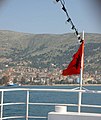| Revision as of 22:32, 9 November 2007 editKhirurg (talk | contribs)Extended confirmed users, Pending changes reviewers, Rollbackers31,704 edits must remain vigilant in the face of albanian nationalism← Previous edit | Revision as of 08:53, 10 November 2007 edit undo217.24.246.110 (talk) Saranda is my hometown and i know more things than some idiots from Greece about itNext edit → | ||
| Line 107: | Line 107: | ||
| }} <!-- Infobox ends --> | }} <!-- Infobox ends --> | ||
| '''Sarandë''' (]: ''Sarandë'', ] {{IPA|/sa'ɾanda/}} or {{IPA|/sa'ɾandə/}}; , "Forty Saints"; ]: ''Άγιοι Σαράντα'' or ''Ágii Saránda'', ]: ''Santi Quaranta''{{IPA|/'aʝi: sa'ɾanda/}}), is the capital of the ] in ], and it is one of the most important tourist attractions of the Albanian Riviera. | '''Sarandë''' (]: ''Sarandë'', ] {{IPA|/sa'ɾanda/}} or {{IPA|/sa'ɾandə/}}; , "Forty Saints"; ]: ''Άγιοι Σαράντα'' or ''Ágii Saránda'', ]: ''Santi Quaranta''{{IPA|/'aʝi: sa'ɾanda/}}), is the capital of the ] in ], and it is one of the most important tourist attractions of the Albanian Riviera. | ||
| In ancient times, the area around Saranda was inhabited by the |
In ancient times, the area around Saranda was inhabited by the ] tribe of the ], one of the three main tribes of ] and formed part of the region of ]. The city was known by latin name, Onchesmos, prior to Byzantine times. | ||
| About 94 per cent of the population are ethnic |
About 94 per cent of the population are ethnic Albanians, with the remainder made up of the greek minority in Albania. | ||
| It was named after the Forty Martyrs of Sebaste traditionally commemorated by the ] on 10 March, during Byzantine times. During the period of Italian annexation in ], the city was renamed "Porto Edda" in honour of ], the eldest daughter of ]. | It was named after the Forty Martyrs of Sebaste traditionally commemorated by the ] on 10 March, during Byzantine times. During the period of Italian annexation in ], the city was renamed "Porto Edda" in honour of ], the eldest daughter of ]. | ||
| Situated on an open sea gulf of the ] at 39.88°N, 20.00°E, the city has a population of about 15,000. Part of its original |
Situated on an open sea gulf of the ] at 39.88°N, 20.00°E, the city has a population of about 15,000. Part of its original population moved to Greece during the large exodus in the early 1990s. Opposite Sarandë is another tourist attraction, the Greek island of ]. There are daily ferries between them. | ||
| Near Sarandë are the remains of ], a ] ]. | Near Sarandë are the remains of ], a ] ]. | ||
Revision as of 08:53, 10 November 2007
39°52′N 20°00′E / 39.867°N 20.000°E / 39.867; 20.000
Place in Vlorë County, Albania| Sarandë | |
|---|---|
 View of Sarande View of Sarande | |
| Country | Albania |
| County | Vlorë County |
| District | Sarandë District |
| Government | |
| • Mayor | Edmond Gjoka (PD) |
| Elevation | 0 m (0 ft) |
| Population | |
| • Total | 15,000 |
| Time zone | UTC+1 (Central European Time) |
Sarandë (Albanian: Sarandë, IPA /sa'ɾanda/ or /sa'ɾandə/; , "Forty Saints"; Greek: Άγιοι Σαράντα or Ágii Saránda, Italian: Santi Quaranta/'aʝi: sa'ɾanda/), is the capital of the District of Sarandë in Albania, and it is one of the most important tourist attractions of the Albanian Riviera. In ancient times, the area around Saranda was inhabited by the illyrian tribe of the Chaonians, one of the three main tribes of Epirus and formed part of the region of Chaonia. The city was known by latin name, Onchesmos, prior to Byzantine times. About 94 per cent of the population are ethnic Albanians, with the remainder made up of the greek minority in Albania. It was named after the Forty Martyrs of Sebaste traditionally commemorated by the Albanian Orthodox Church on 10 March, during Byzantine times. During the period of Italian annexation in World War II, the city was renamed "Porto Edda" in honour of Edda Mussolini, the eldest daughter of Benito Mussolini.
Situated on an open sea gulf of the Ionian at 39.88°N, 20.00°E, the city has a population of about 15,000. Part of its original population moved to Greece during the large exodus in the early 1990s. Opposite Sarandë is another tourist attraction, the Greek island of Corfu. There are daily ferries between them.
Near Sarandë are the remains of Butrint, a UNESCO World Heritage site.
Famous inhabitants
-
 Town Center (By Marc Morell)
Town Center (By Marc Morell)
-
 Ksamil Islets near Sarandë
Ksamil Islets near Sarandë
-
 Saranda from a ferry to Corfu
Saranda from a ferry to Corfu
See also
| Cities and towns in Albania share the status of a geographic unit which makes up a municipality. | |
| (74) |
|